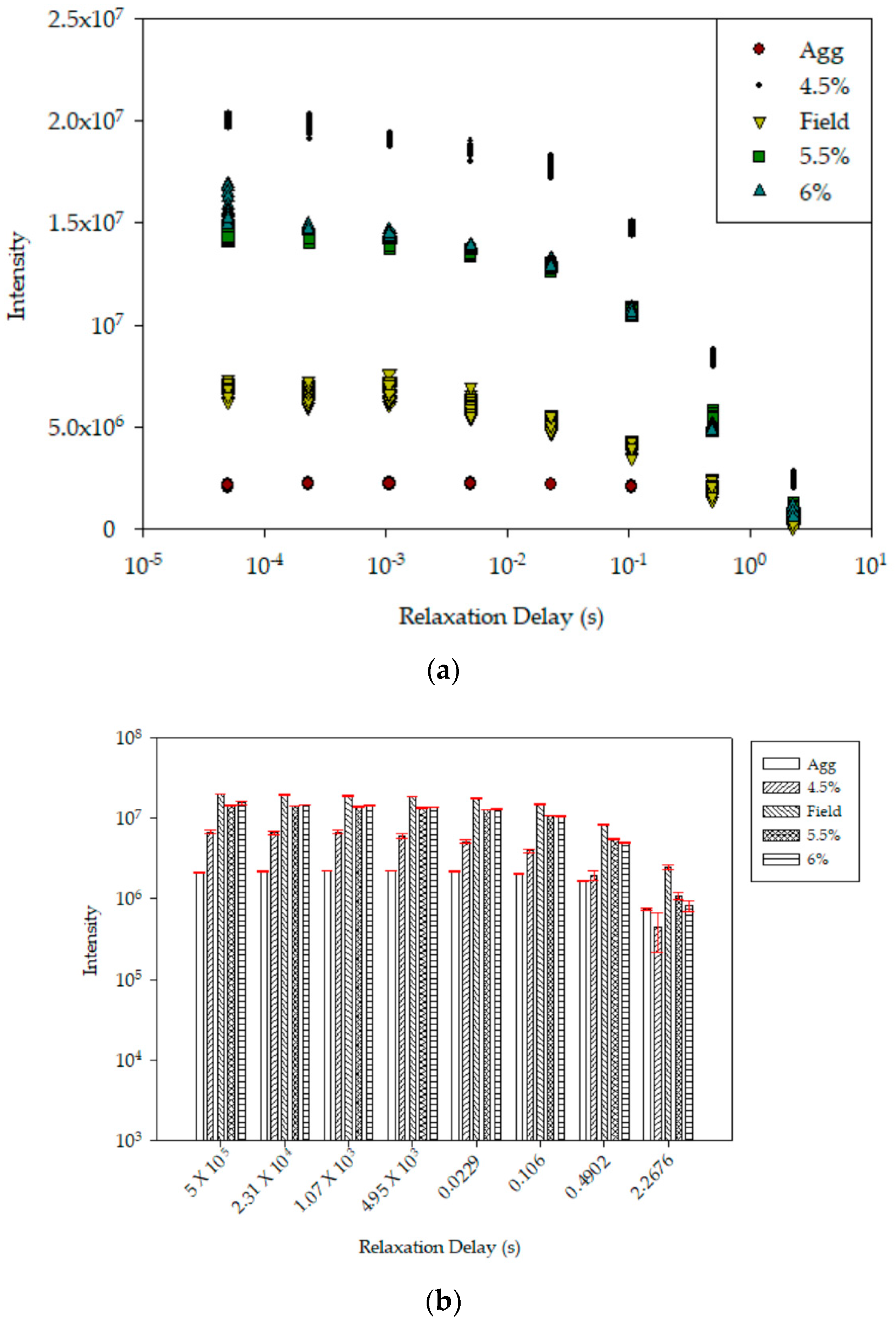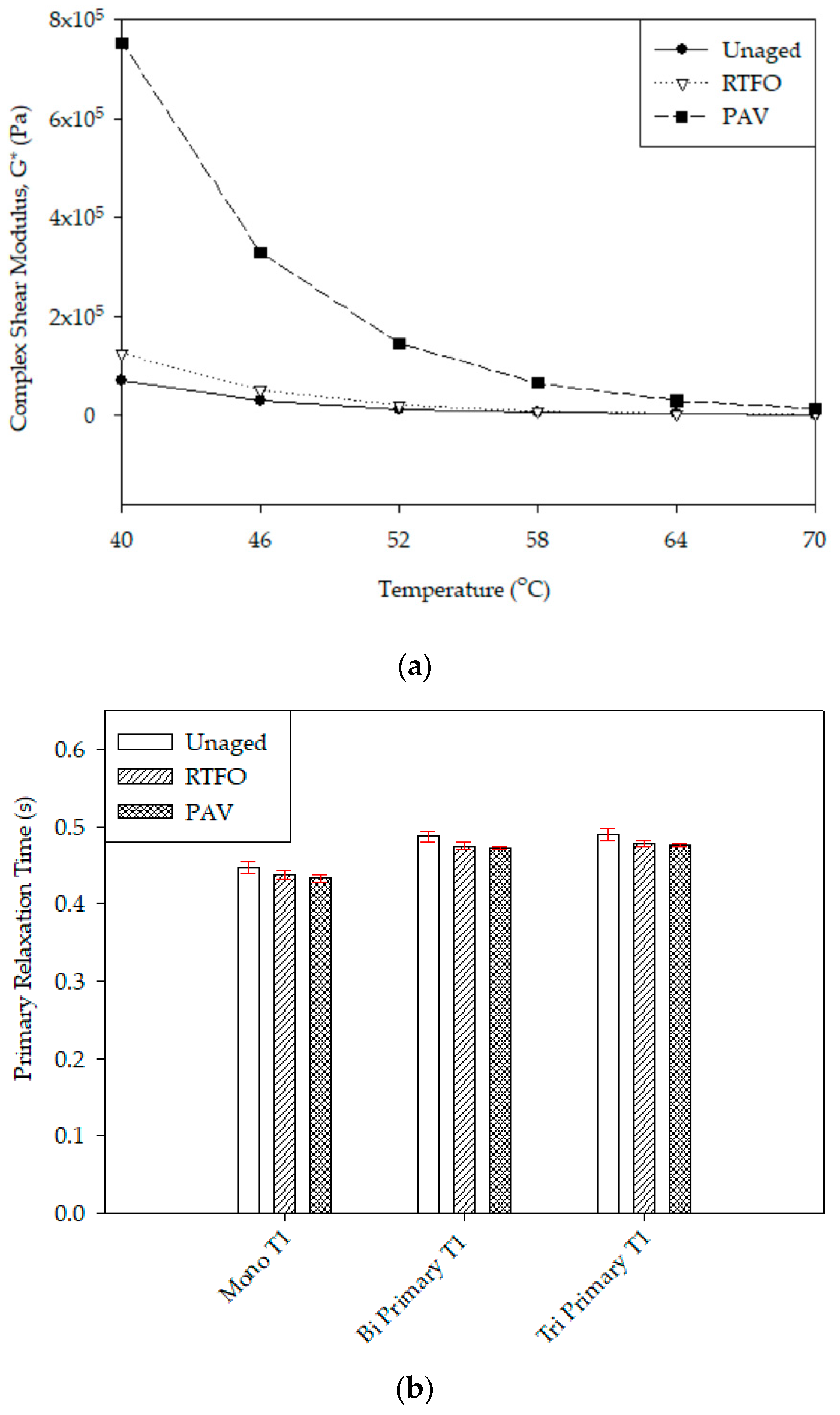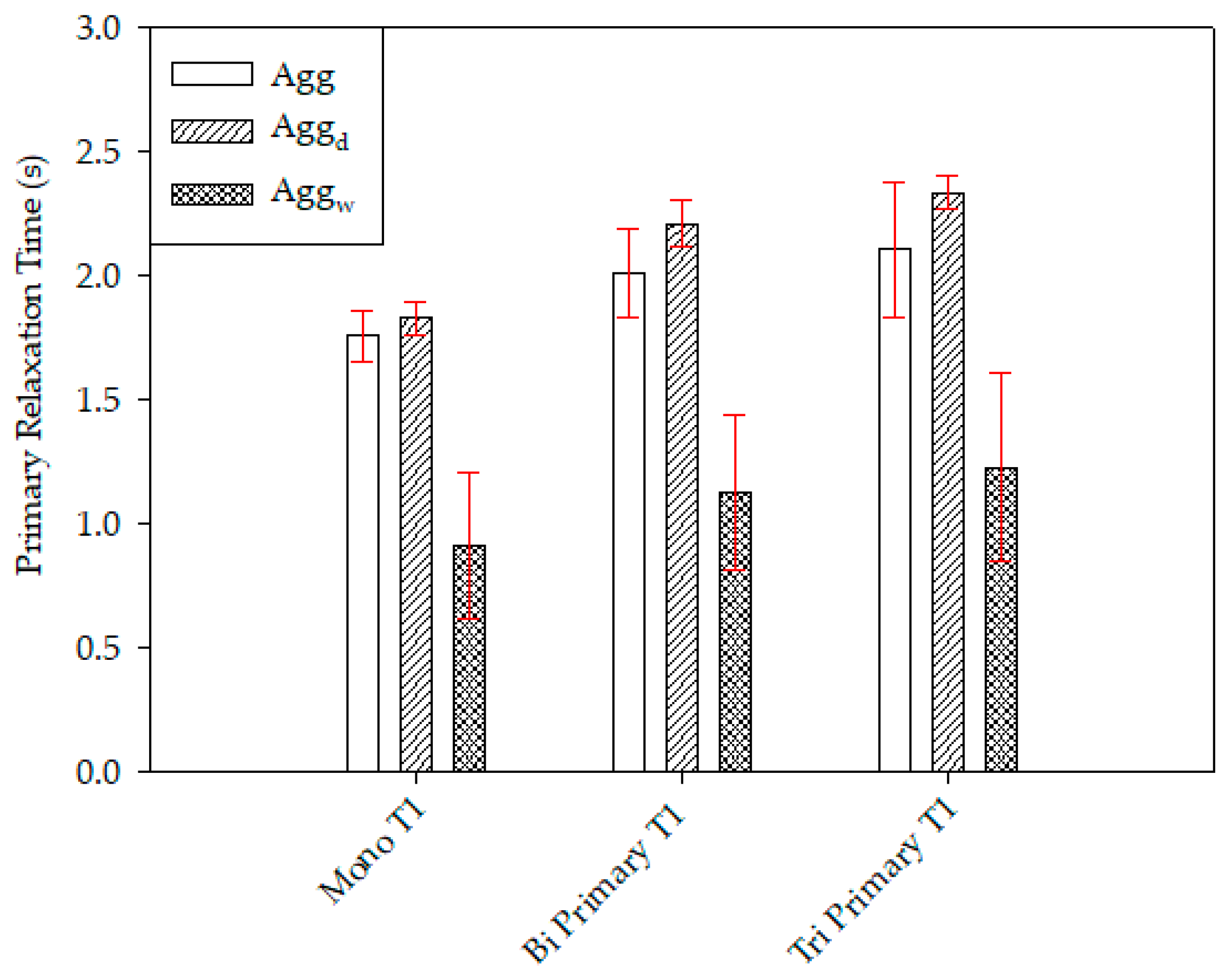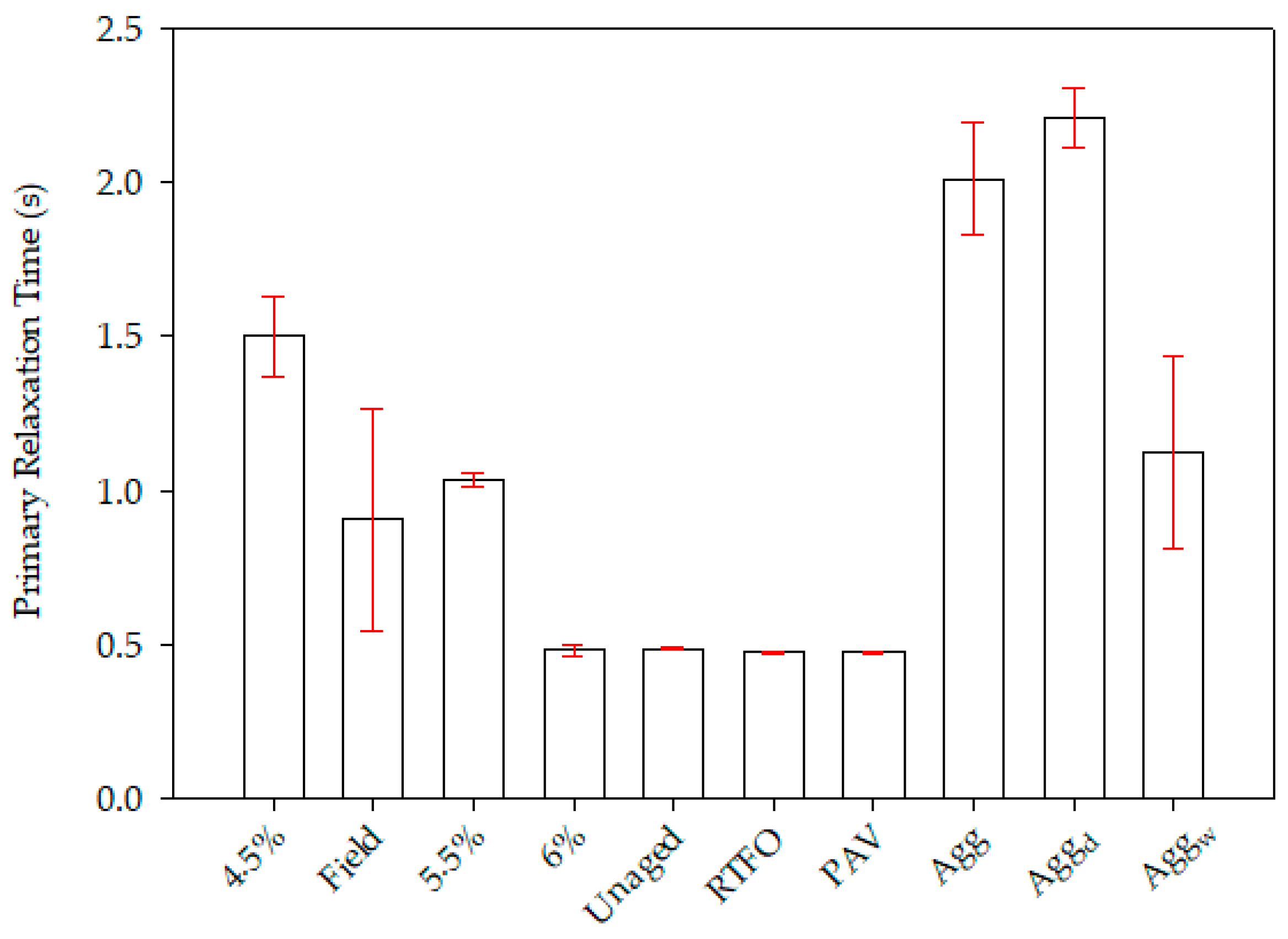Asphalt-Binder Mixtures Evaluated by T1 NMR Relaxometry
Abstract
:1. Introduction
2. Materials and Methods
3. Results
3.1. Noise
3.2. Binder Comparison
3.3. Mixture Comparison
3.4. Aggregate Comparison
4. Discussion
4.1. Binder Aging
4.2. Hot Mix Asphalt
4.3. Aggregate
5. Conclusions
- NMR relaxometry was shown to be able to differentiate asphalt mixtures based on asphalt content. The average primary relaxation times of the 4.5%, field, 5.5%, and 6% HMA were 1.5, 1.06, 0.92, and 0.47 s, respectively;
- The hydrogen environments of aggregate were concluded to be from moisture in adsorbed and crystalline states. The average relaxation time of regular, dry, and wet aggregate was 2.01, 2.21, and 1.13, respectively;
- In relation to the asphalt mixtures, these water environments indicate the susceptibility to water damage and are expected to be the reason for the differences between the mixture samples as detected by NMR;
- While large differences between unaged, RTFO, and PAV binders were not detected with NMR relaxometry, asphalt mixtures, binders, and aggregates could be differentiated. When the aggregate was more prevalent, the primary relaxation time was closer to 1 s; otherwise, the primary relaxation time was close to 0.5 s.
Author Contributions
Funding
Data Availability Statement
Acknowledgments
Conflicts of Interest
References
- Li, B.; Han, J.; Nan, X.; Li, X.; Li, X.; Zhang, P. Adhesion Characteristics and Spectroscopic Analysis of Regenerated Ultraviolet Aged Asphalt Binder Using Waste Vegetable Oil. Case Stud. Constr. Mater. 2023, 18, e01853. [Google Scholar] [CrossRef]
- Niu, D.; Xie, X.; Zhang, Z.; Niu, Y.; Yang, Z. Influence of Binary Waste Mixtures on Road Performance of Asphalt and Asphalt Mixture. J. Clean. Prod. 2021, 298, 126842. [Google Scholar] [CrossRef]
- Sharma, A.; Rongmei Naga, G.R.; Kumar, P.; Rai, P. Mix Design, Development, Production and Policies of Recycled Hot Mix Asphalt: A Review. J. Traffic Transp. Eng. (Engl. Ed.) 2022, 9, 765–794. [Google Scholar] [CrossRef]
- Zahoor, M.; Nizamuddin, S.; Madapusi, S.; Giustozzi, F. Sustainable Asphalt Rejuvenation Using Waste Cooking Oil: A Comprehensive Review. J. Clean. Prod. 2021, 278, 123304. [Google Scholar] [CrossRef]
- Fang, Y.; Zhang, Z.; Yang, J.; Li, X. Comprehensive Review on the Application of Bio-Rejuvenator in the Regeneration of Waste Asphalt Materials. Constr. Build. Mater. 2021, 295, 123631. [Google Scholar] [CrossRef]
- Kumar, A.; Choudhary, R.; Kumar, A. Evaluation of Waste Tire Pyrolytic Oil as a Rejuvenation Agent for Unmodified, Polymer-Modified, and Rubber-Modified Aged Asphalt Binders. J. Mater. Civ. Eng. 2022, 34, 04022246. [Google Scholar] [CrossRef]
- International Road Federation Total Road Network (by Paved and Unpaved). Available online: https://datawarehouse.worldroadstatistics.org/dashboard/checksumgraph (accessed on 20 June 2024).
- Scholz, T. Durability of Bituminous Paving Mixtures. Ph.D. Thesis, University of Nottingham, Nottignham, UK, 1995. [Google Scholar]
- Zaumanis, M.; Poulikakos, L.D.; Partl, M.N. Performance-Based Design of Asphalt Mixtures and Review of Key Parameters. Mater. Des. 2018, 141, 185–201. [Google Scholar] [CrossRef]
- Yaro, N.S.A.; Sutanto, M.H.; Habib, N.Z.; Napiah, M.; Usman, A.; Al-Sabaeei, A.M.; Rafiq, W. Mixture Design-Based Performance Optimization via Response Surface Methodology and Moisture Durability Study for Palm Oil Clinker Fine Modified Bitumen Asphalt Mixtures. Int. J. Pavement Res. Technol. 2024, 17, 123–150. [Google Scholar] [CrossRef]
- Yousefi, A.A.; Haghshenas, H.F.; Shane Underwood, B.; Harvey, J.; Blankenship, P. Performance of Warm Asphalt Mixtures Containing Reclaimed Asphalt Pavement, an Anti-Stripping Agent, and Recycling Agents: A Study Using a Balanced Mix Design Approach. Constr. Build. Mater. 2023, 363, 129633. [Google Scholar] [CrossRef]
- Airey, G.D. Fundamental Binder and Practical Mixture Evaluation of Polymer Modified Bituminous Materials. Int. J. Pavement Eng. 2004, 5, 137–151. [Google Scholar] [CrossRef]
- Xu, H.; Guo, W.; Tan, Y. Permeability of Asphalt Mixtures Exposed to Freeze-Thaw Cycles. Cold Reg. Sci. Technol. 2016, 123, 99–106. [Google Scholar] [CrossRef]
- Rajib, A.I.; Samieadel, A.; Zalghout, A.; Kaloush, K.E.; Sharma, B.K.; Fini, E.H. Do All Rejuvenators Improve Asphalt Performance? Road Mater. Pavement Des. 2022, 23, 358–376. [Google Scholar] [CrossRef]
- Xu, T.; Huang, X. Investigation into Causes of In-Place Rutting in Asphalt Pavement. Constr. Build. Mater. 2012, 28, 525–530. [Google Scholar] [CrossRef]
- Du, H.; Ni, F.; Ma, X. Crack Resistance Evaluation for In-Service Asphalt Pavements by Using SCB Tests of Layer-Core Samples. J. Mater. Civ. Eng. 2021, 33, 04020418. [Google Scholar] [CrossRef]
- Shen, S.; Lu, X.; Liu, L.; Zhang, C. Investigation of the Influence of Crack Width on Healing Properties of Asphalt Binders at Multi-Scale Levels. Constr. Build. Mater. 2016, 126, 197–205. [Google Scholar] [CrossRef]
- Zhang, K.; Zhang, Z.; Luo, Y. Inspection Method and Evaluation Standard Based on Cylindrical Core Sample for Rutting Resistance of Asphalt Pavement. Measurement 2018, 117, 241–251. [Google Scholar] [CrossRef]
- Yan, C.; Zhang, Y.; Bahia, H.U. Predicting Rutting Performance of Asphalt Mixture from Binder Properties and Mixture Design Variables. Road Mater. Pavement Des. 2022, 23, 62–79. [Google Scholar] [CrossRef]
- Heydari, S.; Hajimohammadi, A.; Haji Seyed Javadi, N.; Jeremy Kien Chung Ng, J.; Emmanuel Kypreos, J.; Khalili, N. Modified Asphalt by Coffee Cup Fibres: An Optimum Mix Design Using Response Surface Method. Constr. Build. Mater. 2023, 401, 133005. [Google Scholar] [CrossRef]
- Tan, Y.; Guo, M. Using Surface Free Energy Method to Study the Cohesion and Adhesion of Asphalt Mastic. Constr. Build. Mater. 2013, 47, 254–260. [Google Scholar] [CrossRef]
- Kliewer, J.E.; Bell, C.A.; Sosnovske, D.A. Investigation of the Relationship between Field Performance and Laboratory Aging Properties of Asphalt Mixtures; ASTM International: West Conshohocken, PA, USA, 1995. [Google Scholar] [CrossRef]
- Chen, D. Evaluating Asphalt Pavement Surface Texture Using 3D Digital Imaging. Int. J. Pavement Eng. 2020, 21, 416–427. [Google Scholar] [CrossRef]
- Miller, T.; Swiertz, D.; Tashman, L.; Tabatabaee, N.; Bahia, H.U. Characterization of Asphalt Pavement Surface Texture. Transp. Res. Rec. 2012, 2295, 19–26. [Google Scholar] [CrossRef]
- Chen, D.; Roohi Sefidmazgi, N.; Bahia, H. Exploring the Feasibility of Evaluating Asphalt Pavement Surface Macro-Texture Using Image-Based Texture Analysis Method. Road Mater. Pavement Des. 2015, 16, 405–420. [Google Scholar] [CrossRef]
- Hu, J.; Qian, Z.; Liu, Y.; Zhang, M. Higherature Failure in Asphalt Mixtures Using Micro-Structural Investigation and Image Analysis. Constr. Build. Mater. 2015, 84, 136–145. [Google Scholar] [CrossRef]
- Blümich, B.; Teymouri, Y.; Clark, R. NMR on the Road: Non-Destructive Characterization of the Crumb-Rubber Fraction in Asphalt. Appl. Magn. Reson. 2019, 50, 497–509. [Google Scholar] [CrossRef]
- Shikhov, I.; Thomas, D.S.; Arns, C.H. On the Optimum Aging Time: Magnetic Resonance Study of Asphaltene Adsorption Dynamics in Sandstone Rock. Energy Fuels 2019, 33, 8184–8201. [Google Scholar] [CrossRef]
- Menapace, I.; Garcia Cucalon, L.; Kaseer, F.; Masad, E.; Epps Martin, A. Application of Low Field Nuclear Magnetic Resonance to Evaluate Asphalt Binder Viscosity in Recycled Mixes. Constr. Build. Mater. 2018, 170, 725–736. [Google Scholar] [CrossRef]
- Wang, Y.; Yuan, Q.; Deng, D.; Ye, T.; Fang, L. Measuring the Pore Structure of Cement Asphalt Mortar by Nuclear Magnetic Resonance. Constr. Build. Mater. 2017, 137, 450–458. [Google Scholar] [CrossRef]
- Loise, V.; Caputo, P.; Porto, M.; Teltayev, B.; Angelico, R.; Oliviero Rossi, C. Unravelling the Role of a Green Rejuvenator Agent in Contrasting the Aging Effect on Bitumen: A Dynamics Rheology, Nuclear Magnetic Relaxometry and Self-Diffusion Study. Colloids Surf. A Physicochem. Eng. Asp. 2020, 603, 125182. [Google Scholar] [CrossRef]
- Herndon, R.; Balasubramanian, J.; Woelk, K.; Abdelrahman, M. Investigating the Physical and Chemical Effects of UV Aging on TPO-Modified Asphalt Binder. Mod. Concepts Mater. Sci. 2024, 6. [Google Scholar] [CrossRef]
- Herndon, R.M.; Balasubramanian, J.; Woelk, K.; Abdelrahman, M. Physical and Chemical Methods to Assess Performance of TPO-Modified Asphalt Binder. Appl. Sci. 2024, 14, 3300. [Google Scholar] [CrossRef]
- Missouri Department of Transportation EPG 450.1 Asphalt Binder. Available online: https://epg.modot.org/index.php/Category:450_Bituminous_Pavement_Design (accessed on 23 July 2024).
- Indiana Department of Transportation. Section 902—Asphalt Materials; Indiana Department of Transportation: Indianapolis, IN, USA, 2024.
- Illinois Department of Transportation. Section 1032, Bituminous Materials; Illinois Department of Transportation: Springfield, IL, USA, 2024.
- Iowa Department of Transportation. Section 4137 Asphalt Binder; Iowa Department of Transportation: Ames, IA, USA, 2020.
- Mayes, Z.G.; Rice, W.H.; Chi, L.; Woelk, K.H. A Robust Freeman-Hill-Inspired Pulse Protocol for Ringdown-Free T 1 Relaxation Measurements. J. Magn. Reson. 2023, 352, 107490. [Google Scholar] [CrossRef]
- Noiriel, C.; Gouze, P.; Bernard, D. Investigation of Porosity and Permeability Effects from Microstructure Changes during Limestone Dissolution. Geophys. Res. Lett. 2004, 31, 1–4. [Google Scholar] [CrossRef]
- Cherblanc, F.; Berthonneau, J.; Bromblet, P.; Huon, V. Influence of Water Content on the Mechanical Behaviour of Limestone: Role of the Clay Minerals Content. Rock Mech. Rock Eng. 2016, 49, 2033–2042. [Google Scholar] [CrossRef]







Disclaimer/Publisher’s Note: The statements, opinions and data contained in all publications are solely those of the individual author(s) and contributor(s) and not of MDPI and/or the editor(s). MDPI and/or the editor(s) disclaim responsibility for any injury to people or property resulting from any ideas, methods, instructions or products referred to in the content. |
© 2024 by the authors. Licensee MDPI, Basel, Switzerland. This article is an open access article distributed under the terms and conditions of the Creative Commons Attribution (CC BY) license (https://creativecommons.org/licenses/by/4.0/).
Share and Cite
Herndon, R.M.; Balasubramanian, J.; Abdelrahman, M.; Woelk, K. Asphalt-Binder Mixtures Evaluated by T1 NMR Relaxometry. Physchem 2024, 4, 285-295. https://doi.org/10.3390/physchem4030020
Herndon RM, Balasubramanian J, Abdelrahman M, Woelk K. Asphalt-Binder Mixtures Evaluated by T1 NMR Relaxometry. Physchem. 2024; 4(3):285-295. https://doi.org/10.3390/physchem4030020
Chicago/Turabian StyleHerndon, Rebecca M., Jay Balasubramanian, Magdy Abdelrahman, and Klaus Woelk. 2024. "Asphalt-Binder Mixtures Evaluated by T1 NMR Relaxometry" Physchem 4, no. 3: 285-295. https://doi.org/10.3390/physchem4030020




